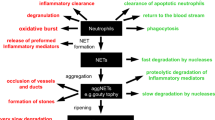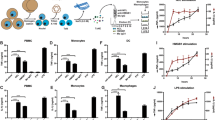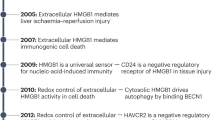Abstract
Serum amyloid P component (SAP), a highly conserved plasma protein named for its universal presence in amyloid deposits1, is the single normal circulating protein that shows specific calcium-dependent binding to DNA and chromatin in physiological conditions2,3. The avid binding of SAP displaces H1-type histones and thereby solubilizes native long chromatin, which is otherwise profoundly insoluble at the physiological ionic strength of extracellular fluids4. Furthermore, SAP binds in vivo both to apoptotic cells5, the surface blebs of which bear chromatin fragments6, and to nuclear debris released by necrosis7. SAP may therefore participate in handling of chromatin exposed by cell death2,3,4,7. Here we show that mice with targeted deletion of the SAP gene8 spontaneously develop antinuclear autoimmunity and severe glomerulonephritis, a phenotype resembling human systemic lupus erythematosus, a serious autoimmune disease. The SAP–/– mice also have enhanced anti-DNA responses to immunization with extrinsic chromatin, and we demonstrate that degradation of long chromatin is retarded in the presence of SAP both in vitro and in vivo. These findings indicate that SAP has an important physiological role, inhibiting the formation of pathogenic autoantibodies against chromatin and DNA, probably by binding to chromatin and regulating its degradation.
This is a preview of subscription content, access via your institution
Access options
Subscribe to this journal
Receive 12 print issues and online access
$209.00 per year
only $17.42 per issue
Buy this article
- Purchase on Springer Link
- Instant access to full article PDF
Prices may be subject to local taxes which are calculated during checkout


Similar content being viewed by others
References
Pepys, M.B. et al. Amyloid P component. A critical review. Amyloid: Int. J. Exp. Clin. Invest. 4, 274– 295 (1997).
Pepys, M.B. & Butler, P.J.G. Serum amyloid P component is the major calcium-dependent specific DNA binding protein of the serum. Biochem. Biophys. Res. Commun. 148, 308– 313 (1987).
Pepys, M.B., Booth, S.E., Tennent, G.A., Butler, P.J.G. & Williams, D.G. Binding of pentraxins to different nuclear structures: C-reactive protein binds to small nuclear ribonucleoprotein particles, serum amyloid P component binds to chromatin and nucleoli. Clin. Exp. Immunol. 97, 152–157 (1994).
Butler, P.J.G., Tennent, G.A. & Pepys, M.B. Pentraxin-chromatin interactions. Serum amyloid P component specifically displaces H1-type histones and solubilizes native long chromatin. J. Exp. Med. 172, 13– 18 (1990).
Hintner, H. et al. Amyloid P component binds to keratin bodies in human skin and to isolated keratin filament aggregates in vitro. J. Invest. Dermatol. 91, 22–28 (1988).
Casciola-Rosen, L.A., Anhalt, G. & Rosen, A. Autoantigens targeted in systemic lupus erythematosus are clustered in two populations of surface structures on apoptotic keratinocytes. J. Exp. Med. 179, 1317– 1330 (1994).
Breathnach, S.M. et al. Serum amyloid P component binds to cell nuclei in vitro and to in vivo deposits of extracellular chromatin in systemic lupus erythematosus. J. Exp. Med. 170, 1433 –1438 (1989).
Botto, M. et al. Amyloid deposition is delayed in mice with targeted deletion of the serum amyloid P component gene. Nature Medicine 3, 855–859 (1997).
Pepys, M.B. & Baltz, M.L. Acute phase proteins with special reference to C-reactive protein and related proteins (pentaxins) and serum amyloid A protein. Adv. Immunol. 34, 141 –212 (1983).
Tennent, G.A., Lovat, L.B. & Pepys, M.B. Serum amyloid P component prevents proteolysis of the amyloid fibrils of Alzheimer's disease and systemic amyloidosis. Proc. Natl. Acad. Sci. USA 92, 4299– 4303 (1995).
Botto, M. et al. Homozygous C1q deficiency causes glomerulonephritis associated with multiple apoptotic bodies. Nature Genet. 19, 56–59 (1998).
Hutchinson, W.L., Noble, G.E., Hawkins, P.N. & Pepys, M.B. The pentraxins, C-reactive protein and serum amyloid P component, are cleared and catabolized by hepatocytes in vivo. J. Clin. Invest. 94, 1390–1396 ( 1994).
Burlingame, R.W., Volzer, M.A., Harris, J. & Du Clos, T.W. The effect of acute phase proteins on clearance of chromatin from the circulation of normal mice. J. Immunol. 156, 4783– 4788 (1996).
Gauthier, V.J., Tyler, L.N. & Mannik, M. Blood clearance kinetics and liver uptake of mononucleosomes in mice. J. Immunol. 156, 1151– 1156 (1996).
Pepys, M.B., Lanham, J.G. & de Beer, F.C. in Clinics in the Rheumatic Diseases (eds. Hughes, G.R.V.) 91–103 (W.B. Saunders, Eastbourne, UK, 1982).
Emsley, J. et al. Structure of pentameric human serum amyloid P component. Nature 367, 338–345 ( 1994).
Thompson, D., Pepys, M.B. & Wood, S.P. The physiological structure of human C-reactive protein and its complex with phosphocholine. Structure 7, 169–177 (1999).
Pepys, M.B., Baltz, M., Gomer, K., Davies, A.J.S. & Doenhoff, M. Serum amyloid P-component is an acute-phase reactant in the mouse. Nature 278, 259– 261 (1979).
Rordorf, C., Schnebli, H.P., Baltz, M.L., Tennent, G.A. & Pepys, M.B. The acute phase response in (NZBxNZW)F 1 and MRL/l mice. Contrasting patterns resembling those in human systemic lupus erythematosus and rheumatoid arthritis respectively. J. Exp. Med. 156, 1268–1273 ( 1982).
Du Clos, T.W. C-reactive protein reacts with the U1 small nuclear ribonucleoprotein. J. Immunol. 143, 2553–2559 (1989).
Reichlin, M. et al. Lupus autoantibodies to native DNA cross-react with the A and D snRNP polypeptides. J. Clin. Invest. 93, 443–449 (1994).
Nakayama, S., Du Clos, T.W., Gewurz, H. & Mold, C. Inhibition of antibody responses to phosphocholine by C-reactive protein. J. Immunol. 132, 1336–1340 (1984).
Hughes, G.R.V. Hughes syndrome: the antiphospholipid syndrome. J. R. Coll. Physicians Lond. 32, 260–264 ( 1998).
Molden, D.P., Nakamura, R.M. & Tan, E.M. Standardization of the immunofluorescence test for autoantibody to nuclear antigens (ANA): use of reference sera of defined antibody specificity. Am. J. Clin. Pathol. 82, 57 –66 (1984).
Isenberg, D.A. et al. Measurement of anti-DNA antibodies: a reappraisal using five different methods. Ann. Rheum. Dis. 46, 448–456 (1987).
Burlingame, R.W. & Rubin, R.L. Subnucleosome structures as substrates in enzyme-linked immunosorbent assays. J. Immunol. Methods 134, 187–199 (1990).
Pepys, M.B., Dash, A.C., Fielder, A.H.L. & Mirjah, D.D. Isolation and study of murine C3. Immunology 33, 491–499 (1977).
Mather, S.J. & Ward, B.G. High efficiency iodination of monoclonal antibodies for radiotherapy. J. Nucl. Med. 28, 1034–1036 (1987).
Acknowledgements
This work was supported by UK Medical Research Council Programme Grant G79700510 to M.B.P. and by The Arthritis & Rheumatism Council.
Author information
Authors and Affiliations
Rights and permissions
About this article
Cite this article
Bickerstaff, M., Botto, M., Hutchinson, W. et al. Serum amyloid P component controls chromatin degradation and prevents antinuclear autoimmunity. Nat Med 5, 694–697 (1999). https://doi.org/10.1038/9544
Received:
Accepted:
Issue Date:
DOI: https://doi.org/10.1038/9544
This article is cited by
-
Comparative analysis of affected and unaffected areas of systemic sclerosis skin biopsies by high-throughput proteomic approaches
Arthritis Research & Therapy (2020)
-
Clusterin facilitates apoptotic cell clearance and prevents apoptotic cell-induced autoimmune responses
Cell Death & Disease (2016)
-
Hepatocytes: a key cell type for innate immunity
Cellular & Molecular Immunology (2016)
-
Polymorphism of C3 complement in association with myocardial infarction in a sample of central Tunisia
Diagnostic Pathology (2013)
-
Serum amyloid P component facilitates DNA clearance and inhibits plasmid transfection: implications for human DNA vaccine
Gene Therapy (2012)



